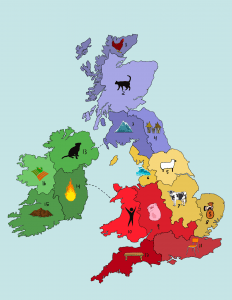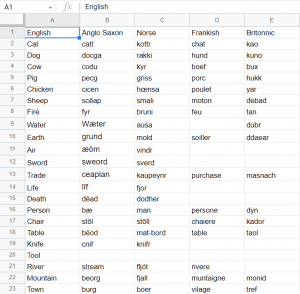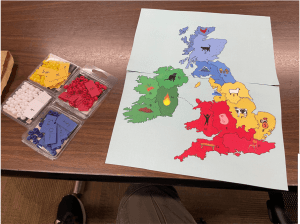After getting the prompt for the final project, I quickly realized that I wanted to make the game revolve around language. Despite being something people use every day to communicate with each other, language is not explored in games very often, and I wanted to see what themes I could explore with it. I quickly settled on a game paralleling the way the English Language has evolved over time. After refining my idea more, I eventually outlined a game like Risk where the territory contested by players also equates to words in the English dictionary.
My chief inspiration was an art video game discussed in class where the player rearranged words in a sentence to manipulate the rules of the game itself. I really loved the concept of playing with words and it definitely sent in the direction of my finished project. Another inspiration was the concept of appropriation that often came up during class. I really enjoy games that play with the rules and concepts of existing games and I felt like doing so would be a good starting off point.
My first step in creating the game was making the map. Because the game involved players fighting over the English language, I felt like an appropriate map would be one of Great Britain.
The concept of the game is that each player takes control of one of four language groups that have influenced the English language: Old Brittonic, Anglo-Saxon, Old Norse, and Frankish. Old Brittonic was a Celtic language and the first spoken in Britain. Anglo-Saxon was spoken by Germanic invaders who conquered and settled Great Britain during the Dark ages. Old Norse was spoken by Scandinavian conquerors who settled large parts of Britain before being repulsed by the Anglo-Saxons. Frankish was spoken by the Normans who conquered Britain and established England as we know it today. Frankish was a hybrid Germanic and Romance language spoken in modern day France. In each region on the map were symbols that each language had a word for. When a player takes a region, they place a small slip of paper with that has their language’s word for the symbol on the region. Every symbol and its corresponding cards were also given numbers to make gameplay easier.
After I finished the map, I began to collect words from the four languages into a google sheet. This proved to be by far the most challenging part of this project. While I could find comprehensive dictionaries translating to English of both Anglo-Saxon and Old Norse, Frankish and Old Brittonic proved more challenging. Fortunately for me, in the English language’s history, Frankish sort of won out, and a lot of English words come from that language. Brittonic, on the other hand, was incredibly challenging. Brittonic was the first language spoken and Britain, and was gradually erased by a revolving door of Norse, Anglo-Saxon, and Norman-Frankish invasions. I was able to find some Brittonic words, but for the most part I had to delve into languages that evolved from it to fill out my list. For this I used Welsh and Breton, Welsh being the historical language of Wales and Breton being spoken in the French province of Brittany, which was settled by Britons pushed out of England by the Anglo-Saxons. Most of the words in these two languages are quite similar because of their common ancestry, but when the two disagreed I went for the Welsh word because I felt like the lack of French influence would make it better reflect Old Brittonic.

This is a good time to point out that I am not a professional linguist or a philologist (language historian). I tried my best, but my dictionaries are not perfect. Some other important factors to acknowledge are that during the time period these languages existed in, language was very decentralized and often changed region to region. Someone speaking Anglo-Saxon in one part of England was not necessarily speaking the same language as an Anglo-Saxon in another part. Also, while I’m pretty sure each word I found roughly translates to the symbols on the map, that doesn’t mean that the word precisely has that definition nor does it mean that there aren’t more precise words I could have used. That being said I was chiefly aiming for the appearance of old languages, and even if the dictionaries I assembled aren’t perfect, they still fill the purpose I needed them to.
After assembling the dictionary I began to piece together the physical game. I bought beads to be used as pieces, created the word cards, and printed out the map.

Because of all the research involved, I was only able to get my game together before the day where we presented, so it was also my first play test. Despite this the test went really well, but there were a few hiccups in the rules that needed to be sorted out on the go. Fortunately my group were super responsive and quick to give feedback one what could be improved. One great example was how in my original rules when one player attacks another and one has more pieces than another, the player with more pieces rolls more dice, just like in risk. However in my version the player with more dice adds the die together, which makes defending against much larger forces virtually impossible. The players quickly pointed this out early on so we changed the rule to the highest single die wins with tie going to the defender, which was the original rule from Risk.

I really enjoyed this project and I honestly think I might continue working on it. I already have some ideas on how to improve the game, such as making the map physically bigger and adding more regions, and it would be interesting to see how much I can polish it as a game.
